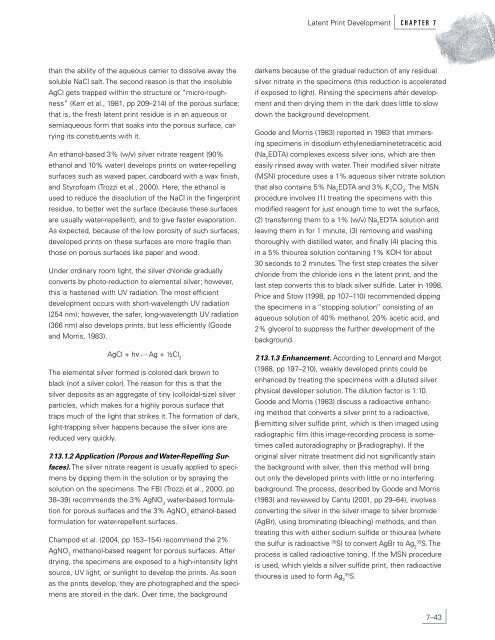Latent Print Development - National Criminal Justice Reference ...
Latent Print Development - National Criminal Justice Reference ...
Latent Print Development - National Criminal Justice Reference ...
You also want an ePaper? Increase the reach of your titles
YUMPU automatically turns print PDFs into web optimized ePapers that Google loves.
than the ability of the aqueous carrier to dissolve away the<br />
soluble NaCl salt. The second reason is that the insoluble<br />
AgCl gets trapped within the structure or “micro-roughness”<br />
(Kerr et al., 1981, pp 209–214) of the porous surface;<br />
that is, the fresh latent print residue is in an aqueous or<br />
semiaqueous form that soaks into the porous surface, carrying<br />
its constituents with it.<br />
An ethanol-based 3% (w/v) silver nitrate reagent (90%<br />
ethanol and 10% water) develops prints on water-repelling<br />
surfaces such as waxed paper, cardboard with a wax finish,<br />
and Styrofoam (Trozzi et al., 2000). Here, the ethanol is<br />
used to reduce the dissolution of the NaCl in the fingerprint<br />
residue, to better wet the surface (because these surfaces<br />
are usually water-repellent), and to give faster evaporation.<br />
As expected, because of the low porosity of such surfaces,<br />
developed prints on these surfaces are more fragile than<br />
those on porous surfaces like paper and wood.<br />
Under ordinary room light, the silver chloride gradually<br />
converts by photo-reduction to elemental silver; however,<br />
this is hastened with UV radiation. The most efficient<br />
development occurs with short-wavelength UV radiation<br />
(254 nm); however, the safer, long-wavelength UV radiation<br />
(366 nm) also develops prints, but less efficiently (Goode<br />
and Morris, 1983).<br />
AgCl + hν Ag + ½Cl 2<br />
The elemental silver formed is colored dark brown to<br />
black (not a silver color). The reason for this is that the<br />
silver deposits as an aggregate of tiny (colloidal-size) silver<br />
particles, which makes for a highly porous surface that<br />
traps much of the light that strikes it. The formation of dark,<br />
light-trapping silver happens because the silver ions are<br />
reduced very quickly.<br />
7.13.1.2 Application (Porous and Water-Repelling Surfaces).<br />
The silver nitrate reagent is usually applied to specimens<br />
by dipping them in the solution or by spraying the<br />
solution on the specimens. The FBI (Trozzi et al., 2000, pp<br />
38–39) recommends the 3% AgNO water-based formula-<br />
3<br />
tion for porous surfaces and the 3% AgNO ethanol-based<br />
3<br />
formulation for water-repellent surfaces.<br />
Champod et al. (2004, pp 153–154) recommend the 2%<br />
AgNO methanol-based reagent for porous surfaces. After<br />
3<br />
drying, the specimens are exposed to a high-intensity light<br />
source, UV light, or sunlight to develop the prints. As soon<br />
as the prints develop, they are photographed and the specimens<br />
are stored in the dark. Over time, the background<br />
<strong>Latent</strong> <strong>Print</strong> <strong>Development</strong> C H A P T E R 7<br />
darkens because of the gradual reduction of any residual<br />
silver nitrate in the specimens (this reduction is accelerated<br />
if exposed to light). Rinsing the specimens after development<br />
and then drying them in the dark does little to slow<br />
down the background development.<br />
Goode and Morris (1983) reported in 1983 that immersing<br />
specimens in disodium ethylenediaminetetracetic acid<br />
(Na EDTA) complexes excess silver ions, which are then<br />
2<br />
easily rinsed away with water. Their modified silver nitrate<br />
(MSN) procedure uses a 1% aqueous silver nitrate solution<br />
that also contains 5% Na EDTA and 3% K CO . The MSN<br />
2 2 3<br />
procedure involves (1) treating the specimens with this<br />
modified reagent for just enough time to wet the surface,<br />
(2) transferring them to a 1% (w/v) Na EDTA solution and<br />
2<br />
leaving them in for 1 minute, (3) removing and washing<br />
thoroughly with distilled water, and finally (4) placing this<br />
in a 5% thiourea solution containing 1% KOH for about<br />
30 seconds to 2 minutes. The first step creates the silver<br />
chloride from the chloride ions in the latent print, and the<br />
last step converts this to black silver sulfide. Later in 1998,<br />
Price and Stow (1998, pp 107–110) recommended dipping<br />
the specimens in a “stopping solution” consisting of an<br />
aqueous solution of 40% methanol, 20% acetic acid, and<br />
2% glycerol to suppress the further development of the<br />
background.<br />
7.13.1.3 Enhancement. According to Lennard and Margot<br />
(1988, pp 197–210), weakly developed prints could be<br />
enhanced by treating the specimens with a diluted silver<br />
physical developer solution. The dilution factor is 1:10.<br />
Goode and Morris (1983) discuss a radioactive enhancing<br />
method that converts a silver print to a radioactive,<br />
β-emitting silver sulfide print, which is then imaged using<br />
radiographic film (this image-recording process is sometimes<br />
called autoradiography or β-radiography). If the<br />
original silver nitrate treatment did not significantly stain<br />
the background with silver, then this method will bring<br />
out only the developed prints with little or no interfering<br />
background. The process, described by Goode and Morris<br />
(1983) and reviewed by Cantu (2001, pp 29–64), involves<br />
converting the silver in the silver image to silver bromide<br />
(AgBr), using brominating (bleaching) methods, and then<br />
treating this with either sodium sulfide or thiourea (where<br />
the sulfur is radioactive 35 35 S) to convert AgBr to Ag S. The<br />
2<br />
process is called radioactive toning. If the MSN procedure<br />
is used, which yields a silver sulfide print, then radioactive<br />
35 thiourea is used to form Ag S. 2<br />
7–43

















